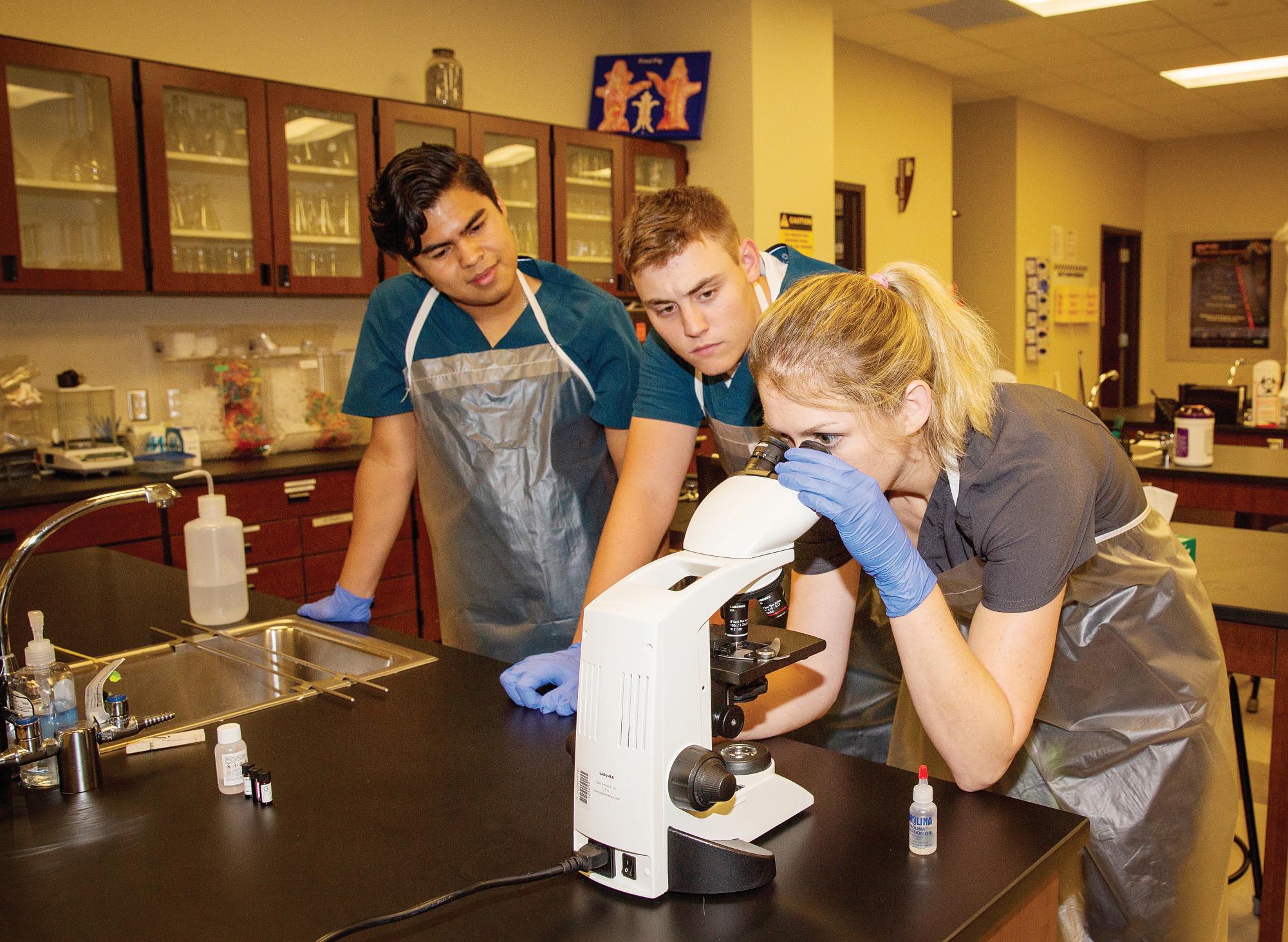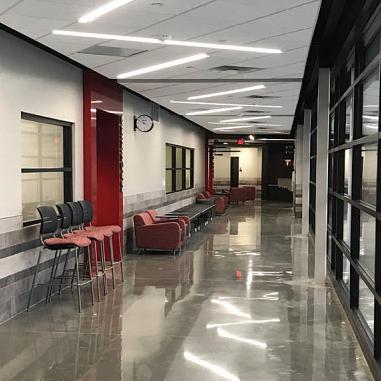
25 minute read
coverage
City looks to eliminate barriers that keep some people out of the workforce
By Kevin Canfield Tulsa World
It’s tempting to begin this story on economic development in Tulsa with a few numbers.
Unemployment is low, after all. And new construction is booming. But as Kian Kamas, the city’s chief of economic development, would tell you, the numbers don’t mean much if they’re not leading to better lives for Tulsans.
“Ultimately, the work that we do funnels down to the lives of families and children throughout Tulsa,” she said. “And if what we’re doing is not positively benefiting the lives of families and children, then we kind of need to rethink our strategy.”
An artist rendering depicts the 11-story, 260,000-square-foot headquarters that WPX is building in the Tulsa Arts District. Court esy
Kamas and her staff do have a strategy, and it hinges on one number: 10.6.
That is the number of years fewer that a person residing in north Tulsa’s 74126 ZIP code can expect to live than a person in the 74137 ZIP code in south Tulsa, according to 2016 figures. In 2020, Kamas said, the city plans to focus its efforts on reducing that number. Several strategies will be in play, including working to eliminate the barriers that continue to keep some people out of the workforce.
But no effort has the potential to move the needle more than helping attract and maintain businesses that can provide well-paying jobs, Kamas said.
“That is, I think, just incredibly important as we think of closing the life-expectancy gap — making sure that people are earning wages that can support a family and that can make sure that they have a quality of lifestyle that they can have access to safe and affordable housing,” she said.
The city will also examine its development incentives to ensure that the projects it supports help achieve the goal of decreasing the life-expectancy gap. “We are really trying to think through how can the projects that we work on or the way that we align our staff really shift that (life-expectancy) reality,” she said.
In 2019, the valuation of building projects permitted by the city reached $3.1 billion. The year before, the valuation was about half that amount.
“Not included in that $3.1 billion last year is the building permit for WPX, or the building permit for The View, or the building permit for the grocery store development across from the PAC, or the Muncie Power Products at 36th (Street) and Peoria (Avenue),” Kamas said. “We feel confident momentum will continue well into 2020.”
Kevin Canfield 918-645-5452 kevin.canfield @tulsaworld.com Twitter: @aWorldofKC
HEALTH CARE Universities help fill holes in coverage
The OSU Center for Health Sciences also operates an addiction clinic in midtown Tulsa. Tulsa World f il e

By Lenzy Krehbiel-Burton For the Tulsa World
It might take a minute, but the doctor will see you now.
Hillcrest Health System, St. John Health System and Saint Francis Health System are still among the city’s largest employers. However, the U.S. Department of Health and Human Services’ Health Resources and Services Administration still classifies Tulsa, like almost all of Oklahoma, as a Health Professional Shortage Area, or one that does not have at least one primary care provider for every 3,500 residents.
With more than 1,500 primary care providers across the Tulsa metro area, the shortage is not as acute compared to the more rural communities. However, it has helped shape efforts from the University of Oklahoma and Oklahoma State University to fill in the coverage gaps.
The OU-TU School of Community Medicine at OU-Tulsa’s Schusterman Campus is working to facilitate access to care for underserved Tulsans through its Community Health Clinic program.
Launched in 2003, the Community Health Clinic includes an evening walk-in clinic and a longitudinal clinic for chronically ill patients. All services, including lab and radiology, are available for free and are funded exclusively through private donations.
According to data compiled by the Centers for Disease Control and Prevention, Oklahoma’s drug overdose rate is 20.1 per 100,000 residents. With that figure slowly climbing due to alcohol, methamphetamine and illegal opioids, such as heroin and fentanyl, the OSU Center for Health Sciences now operates an addiction clinic in midtown Tulsa.
Co-located at 6333 E. Skelly Drive with 12 & 12, the state’s largest comprehensive community addiction resource center, the outpatient clinic offers individualized, evidence-based outpatient treatment for multiple forms of addiction and mental health services for adults.
The facility operates in partnership with Minnesota-based Hazeldon Betty Ford Foundation, the country’s largest nonprofit addiction treatment provider. With almost the entire state still considered a Mental Health Professional Shortage Area by the Health Resources and Services Administration, OSU Center for Health Sciences received an additional $250,000 grant in January from Blue Cross and Blue Shield of Oklahoma to research the effectiveness of telehealth for treating addiction.
“We admire Blue Cross and Blue Shield of Oklahoma’s leadership in expanding access to addiction treatment services,” said Dr. Kayse Shrum, president of OSU Center for Health Sciences and dean of the OSU College of Osteopathic Medicine. “This major investment will allow us to reach more Oklahomans who are struggling with addiction and who would benefit immensely from the expertise at OSU Medicine. We appreciate our continued partnership with Blue Cross and Blue Shield of Oklahoma.” OSU Center for Health Sciences is also taking steps to address the shortage of primary
care providers through a partnership with the Cherokee Nation.
When it opens in August with 50 students, the OSU College of Osteopathic Medicine at Cherokee Nation will be the first tribally affiliated medical school on tribal land in the country.
Located at W.W. Hastings Hospital, the new 84,000-squarefoot medical school’s teaching space will include an anatomy laboratory, a clinical skills lab, an osteopathic manipulative medicine lab, standardized patient labs, three lecture halls and a state-of-the-art simulation center.
“We know there’s a doctor shortage in Oklahoma,” Cherokee Nation Principal Chief Chuck Hoskin Jr. said. “We know across the country, particularly in rural areas, it is difficult to recruit and retain doctors.”

Tulsa Tech launched HireTulsaTechgrads.com, a free service that provides career advice and employment connections in one spot, in 2018.
The school is the first ofOklahoma’s 29 CareerTech centers to employ a program that meets NACE standards.
Tulsa Tech has made it even easier to connect job-seeking students to businesses searching for qualified employees.
As many colleges across the country have fallen behind in their investments in career services,Tulsa Tech has been proactive in improving the quality of its program and incorporating best practices to get more students to use the service.
In 2018,Tulsa Tech began expanding its career services program, hiring a career coordinator for each of its six campus locations to assist with students’ career readiness.
It launched HireTulsaTechgrads.com that year to provide a comprehensive one-stop shop to better serve students, alumni and employers. Program standards were aligned with those of the National Association of Colleges and Employers (NACE), as are all area colleges and universities.
“We’re using the same type of system that any post-secondary institution is offering their students,” said Karen Johnson, director ofTulsa Tech Career Services.“I like for people to know that when our students leave here — and about 40 percent of our students go on to college — they will have already experienced the type of career services program they will see in college.”
Tulsa Tech is the first of Oklahoma’s 29 Career Tech centers to employ a program that meets NACE standards, she said.“We pave the way,” Johnson said.
Since launching the new career services program, student engagement with the program has grown and employer relations have both improved and increased.
One of the highlights of HireTulsaTechgrads.com is direct 24/7 access by students and alumni to area employers.
Thousands of employers are actively seeking employees through Tulsa Tech career services to fill available positions. “Students have a job board specific to what we train for,” Johnson said. Career Services at Tulsa Tech offers so much more than job listings.
The program provides job search, career readiness and networking opportunities, as well as mock interviews, resume reviews and career fairs.The goal is for every student to have a resume uploaded to the system upon completion of their educational program.
“I like to tell students that they don’t want to miss the opportunities on HireTulsaTechgrads.com because many local employers have contacted us trying to find them,” Johnson said.
The benefits go both wa ys.
Employers have access to a significant pool of job applicants who are trained for the jobs they are looking to fill. They also have connections with instructors, alumni and have a voice in helping develop the curriculum Tulsa Tech uses to train students.
“Our advisory members guide us not only on technical skills students will need to be successful in the workplace, but sometimes more importantly what professional skills are needed, such as a work ethic and dependability,” Johnson said.
Overall, 96 percent ofTulsa Tech graduates move on to either fulltime employment, military service or higher education. A large part of the reason is due to Tulsa Tech’s efforts in reaching out and developing relationships with area employers.
In the past 18 months alone, the system has added 1,000 new employers who want to use the service to find new employees, Johnson said. Currently, there are nearly 300 new job postings available for students and alumni to pursue. employees. Not only can they post multiple employment opportunities and in ternships on the job board, but they also can promote their company by helping Tulsa Tech students prepare for the job selection process by offering mock interviews and other resources.
“Oftentimes, this is the first time our students have been through an interview process,” Johnson said.
Also, employers may volunteer to offer industry tours for students or provide speakers in the classrooms, as well as participate in job fairs that Tulsa Tech hosts on various campuses.
“We’re in the business of preparing students for success in the workplace and that includes developing relationships with industry to gauge their workforce needs,” Johnson said.
According to a recent Grow Metro Tulsa survey of industries in 11 counties, every single industrial employer interviewed praised Tulsa Tech for the quality of its facilities, instructors and customer service in regards to meeting employer workforce needs.
Construction, hospitality, information technology, manufacturing, transportation and health sciences are currently the top fields where Tulsa Tech students are engaging with local industry.
“Employers in the Tulsa metro looking to fill any positions should check out HireTulsaTechgrads.com. Our campuses ar e full of eager students who can start right after graduation,” she said.
Tulsa Tech offers a wide range of opportunities to prepare students for success in a career. With six locations throughout the county, a Tulsa Tech campus is never too far away.
For employers, a partnership with Tulsa Tech can be a great boon for their business.
Once an employer signs up with HireTulsaTechgrads.com, they can ‘sell’ their company to potential Tulsa Tech will host a hiring event from 8 a.m.-2 p.m.on April 24 at the Riverside campus.It is open to students and alumni, as well to the public.

IMPROVING YOUR BUSINESS IS OUR BUSINESS

Customized training to meet your needs. Enhancing your training and professional development is more affordable than you might think. We meet with your team and offer our services in our facility or yours, in less time and less money. Strengthen your workforce and gain a competitive edge today!
TO LEARN MORE, CALL US AT (918) 828-5000 OR VISIT TULSATECH.EDU



BUSINESS & INDUSTRY SERVICES
Why Move to the Cloud?

Cloud computing is becoming the new normal for businesses ofall sizes. Here are some benefits associated with making the move to the cloud.
Cloud computing is a technology that uses a network ofremote servers to store,manage and process data,rather than using the traditional local servers your business might have on-site today. “Cloud computing is basically Internet computing,”says Jason Ludwig,sales director for Cox Business. “With the cloud,your company’s critical data and computing resources are securely stored in a remote location and delivered to authorized users through the internet. The‘cloud’really means the same thing as the Internet,”Ludwig says.
Why are so many businesses migrating to the cloud? “It’s because cloud computing provides growth opportunities,scalability,reliable quality, affordable pricing,easy collaboration, and simple data access,”Ludwig explains.“Cox Business Cloud Solutions can help your business in a myriad of ways.” Here are a few ofthe benefits associated with cloud computing.
Virtual Desktops Virtual desktops allow employees to work from the cloud as opposed to depending on a literal desktop. Cloud offers the capability to have all your files on hand and accessible from any device — anywhere,anytime. “Let’s face it,” Ludwig says,“the world has gone mobile. With virtual desktops in the cloud,users can take their desktop environment with them on their tablets,smartphones, laptops and other devices.”
Virtual Servers Virtual servers based in the cloud eliminate the maintenance requirements ofin-house servers. This includes hardware, cabling, cooling devices, backup generators and more. Virtual servers provide flexible, standardized and seamless operating environments; this allows applications to perform at their peak without downtime. And many connectivity resources can be delivered at a“payas-you-go”cost, which allows you to operate like an enterprise-level company, no matter what your size.
Hosted Microsoft Exchange With Microsoft Exchange,businesses can have an entirely cloud-based hosted email solution. “Hosted Microsoft Exchange is a better option,because of its efficiency and simplicity,”Ludwig says. “With Cox Business Cloud Solutions,we manage the migration,which makes installation easy and uncomplicated.” Businesses remain in control of their email solution by tailoring it to their specific needs and ensuring communications are always available. poses the highest risk ofcomplete loss in the event ofa disaster. This risk can be avoided with the cloud. Cloud disaster recovery and business continuity solutions will secure business data and ensure minimal downtime in the event ofa disaster. With the cloud,a company’s business applications and data are always safe and accessible.
Cost Efficiency The time and money that go into traditional IT operations are essentially eliminated with the cloud.Given that the cloud provider manages the hardware and software for you,it’s virtually a capital-expenditure free solution. “Cox Business Cloud Solutions allow a business to pay for what it uses,so you don’t spend money on unneeded services,”Ludwig notes. “It’s really never been easier;a company can free up it’s IT staffto focus on running a business, while also saving money.”
Scalability In the cloud,businesses can scale easily, drive operational efficiency,and manage shifting computing needs with the cloud’s flexible resources.According to Ludwig,“the ability to scale is essential for many organizations,big and small. Infrastructure is expensive,and cloud computing helps businesses avoid these costs while maintaining the ability to scale up or down in any situation.”
Simplicity With the constant advancement of technology and applications,businesses want solutions that are easy to use, no matter what device employees are working from. Not only is the cloud a simple environment to use and navigate, it’s reliable,convenient and constant. “The cloud’s virtual environment provides a familiar interface that’s universal across all devices,”Ludwig explains. “As a cloud provider,we handle the design,testing,migrations and implementations … which lets you and your team focus on running a business.”
Stability The cloud is a reliable resource that performs in a uniform,unvarying way across all devices. Some providers offer unlimited bandwidth running in and out oftheir data centers,which delivers extraordinary performance to users regardless oftheir location or device. With the cloud,desktop environments are always up-and-running.
Mobility Having multiple devices — laptop, tablet,phone and more — is now a normal occurrence for employees and having different data on each one creates an inefficient and insecure situation. Cloud computing removes this burden by providing an all-in-one business solution. “With the cloud, you can access your information from any device through a Web browser or application,”Ludwig adds.“Everything is stored in an accessible and secure cloud environment,so users won’t ever be without their files.”
Security “All businesses want and need high levels ofsecurity,”Ludwig says, “especially those that have highly confidential or delicate information. Cloud computing assures the highest security because we use enterpriseclass solutions for all physical and network security measures. Many ofour solutions meet and exceed standards like HIPAA and PCI.” In addition to protecting a business from viruses, malware,hackers and rogue employees, typical cloud security measures include full redundancy,encryption,biometric scanning,24/7 surveillance and monitoring,firewalls and more.
“Any one,or two,or three ofthe benefits we’ve reviewed is enough to convince many business owners about the cloud’s viability,”Ludwig concludes. “But when you look at all the potential benefits the cloud has to offer,it’s really a no-brainer. That’s why more and more companies are taking advantage ofmanaged cloud services to achieve greater performance, value and focus.”
For more information about Cox Business Cloud Solutions,reach out to your local Cox Business account executive or visit coxbusiness.com/ cloud.

Feel like your provider isn’t setting you up for success? Switch to one who will.
• 24/7 support and network monitoring • Fast, reliable fiber-fueled Internet speeds • Voice solutions you can manage from any device, in and out of the office • Ask about adding the latest WiFi technology
50 Mbps Internet One Voice Line Unlimited Nationwide Calling
$
84 /mo *


for 6 months with a 3-year agreement

Get A $ 200 Cox Business Visa ® Prepaid Card
After Online Redemption†. Mention "Reward Promo" To Qualify.
CALL 918.286.1190 OR VISIT COXBUSINESS.COM TO SWITCH TODAY
Native Oklahoman uses startup expertise to boostTulsatechnologyindustry Aim is to build a larger and increasingly diverse tech workforce Libby Wuller

Libby Wuller is helping to bring to life a booming technology industry in Tulsa.
At just age 24, the Stillwater native has a wealth ofexperience in the startup world and a reputation in the field that belies her age.
She is executive director ofthe Holberton School, an innovative and intensive education program that turns out software engineers in less than two years who are better prepared for the workforce than students who attend traditional universities. But while in college, something else grabbed her attention.
During her sophomore year,Wuller got a call from a friend who was enthusiastic about a new startup he was working on.One ofhis friends from Harvard had developed a software platform that could analyze government data, specifically about members ofCongress.
It mapped voting history and sponsorship data ofmembers of Congress to show who was bipartisan and how legislation had changed from version to version.
The school has just arrived in Tulsa and its first cohort ofnearly 40 students has begun learning how to code software using project-based curriculum.There are no instructors.Students learn in groups oftheir peers.The curriculum is designed by top leaders in the industry. Tuition is deferred and no coding experience is necessary. It is all designed to open software engineering education opportunity to a more diverse group ofstudents and increase the number ofsoftware engineers to meet skyrocketing demand. The only requirements are that a person is 18 years ofage or older and that they have a high school diploma or equivalent. Wuller always thought that after she graduated from George Washington University in Washington, D.C.with a degree in political science, she would go directly into politics as she had always dreamed.She had once interned for Oklahoma Sen.James Inhofe and expected to continue that career path in government or politics. While still attending Harvard University, the startup’s founders were ready to build a team in D.C.who could do market research, shop around the beta software and eventually build up the sales operation. “So, while I was in school, I said yes to what I thought was just going to be a project. It ended up being an incredible journey,” Wuller said. As a member ofthe development team, she not only worked in sales but helped think through the process ofbuilding a scalable operation.She did a lot ofmarketingrelated work, from organizing conferences and events to building out a new sales funnel and metricizing the data that goes along with that. She started as the sixth hire and, when she left, the company had scaled to nearly 100 team members. Quorum continued to grow.Eventually the company brought in several new vice presidents because the early startup team wanted to move on to “their next big thing,”she said.Some began new startups oftheir own while others rejoined politics. ANEW DIRECTION Holberton is changing the way education is done.Its model is designed to open doors to a more diverse talent pool by removing financial and educational obstacles. There are no instructors and no lectures.The school uses an online,project-based curiculum in a peer-to-peer learning environment. Students learn by doing.
It was then that Wuller realized that she missed the early days ofthe startup when there were only a small number of people involved.
“Yes, you worked a lot ofhours, but you could make real change and impact every single day,”she said.
She decided to move to Tulsa and work for Quorum on a remote basis for a while, knowing that she eventually wanted to find a new career opportunity here where the quality of living is high and the cost is low.
Essentially,Wuller came home again.
“When I moved here, I knew networking is the name ofthe game.I spent the summer of2019 taking more than 40 networking coffees to understand wha t the tech scene here is like, what the ecosystem looks like, and essentially, to find places where my expertise could come in and I could make a big impact,” Wuller said.
It wasn’t long before the George Kaiser Family Foundation came calling about an opportunity to help bring the Holberton School to Tulsa.
“They told me they had this brilliant new model where they’re teaching students to become software engineers in under two years and there’s no upfront tuition.They said they needed someone to build out their presence in Tulsa,”Wuller said.
She enthusiastically took the job.
“It’s exactly the right fit,”Wuller said. Even her record ofadvocating across the country to get more women and young people to participate in government aligns perfectly with Holberton’s mission to attract a more diverse software engineering workforce.
Wuller began at Holberton in October last year, overseeing the renovation and build-up ofa historic space downtown at 15 N.Cheyenne Ave.
The school’s next two cohorts begin in June and September.She is busy recruiting at ar ea high schools and businesses to boost enrollment and provide a jump-start for Tulsa’s tech industry.
“My dream is for companies we’re partnering with to come to us and say, ‘Hey, we have some students for you.’ We’d like to see businesses put their employees through the program then hire them back as software engineers,” she said.
What Wuller does as executive director at Holberton is very much like building a startup company from the ground floor.
And that is where she is most comfortable, making change that could transform Tulsa into a thriving tech city.
“We really want to partner with the community,”Wuller said.“We know this is very much a community effort and we won’t be successful unless we all do it together.”

For more information, visit holbertsonschool.com/campus_life/ tulsa.

• 2-year Software Engineering Program • No Upfront Tuition*
$1,500 / mo *
need-based living assistance for qualifying Holberton Tulsa students *conditions apply.
VISIT US ONLINE OR IN PERSON TO FIND OUT MORE. www.holbertonschool.com
Tulsa arts community

TulsaSymphonybusinessmodel onlyoneofitskindinthecountry
According to the U.S. Bureau ofEconomic Analysis and the National Endowment for the Arts, the arts contribute $763.6 billion to the U.S. economy — more than agriculture, transportation or warehousing.
In fact, the arts add four times more financially to the U.S. economy than agriculture and $200 billion more than transportation or warehousing.
Tulsa Symphony and the other arts organizations do the same service for the local economy.
After moving from Aspen to become executive director of Tulsa Symphony, Keith Elder has grown passionate about the unusual way decisions are made at the charitable music organization.
He took the Tulsa position on Aug.1 following leadership roles with the Aspen Music Festival and School, Eastman School ofMusic, the Boston Symphony Orchestra and Boston Pops — all highly regarded institutions in the music world.
But he had never seen something similar to the way operations and programming at Tulsa Symphony are run.
“Everyone in the organization has a voice.Our musicians are fully integrated in running the organization.And everybody works together in planning and programming,”Elder said.
The consensus model ofbusiness is unique to the Tulsa Symphony.In fact, it is the only city symphony in the country to be run on the basis that everybody in the organization has access to a voice in every major decision.
“Egos are checked at the door,”he said.
In the business world, Elder said he often sees the eyerolls from others when he explains how decisions are made at Tulsa Symphony.They can’t believe that a group ofpeople could come to an agreement every time the or ganization makes a move.
“Fifteen years in and it’s very successful,”he said.“It definitely works. And it works beautifully.”
Six ofTulsa Symphony’s 12 staff members are musicians in the orchestras.Each “integrated musician” holds a dual appointment with Tulsa Symphony as both an administrator and a performer.
Musicians also play an active role in each ofthe Tulsa Symphony’s 13 committees, including the artistic committee.That committee acts as the organization’s artistic director and selects the repertoire, conductors and soloists for each season.
In addition, 25 percent ofthe members ofthe Tulsa Symphony board of directors are orchestra musicians and have a major role in the organization’s direction.
“There is no management/employee relationship in our organization.We are all on the same level as far as making any decision that affects the Tulsa Symphony, from programming to fundraising,”Elder said.
The success ofthe model is due precisely to the fact that nothing is dictated from the top.
“Everyone has a voice in major decisions.And everyone is invested in the outcome,”Elder said.
Each major decision is made by the entire organization during meetings, which are scheduled for all memb ers to gather and discuss a specific proposal. After some research and thought, Tulsa Symphony Orchestra members bring their concerns and questions to a second meeting to discuss and come to consensus.
It is there that the group comes to a consensus and, ultimately, makes a decision on the plan moving forward.
“When a decision is dictated from the top, you might have 55 percent on board.But what about the 45 percent of people who aren’t happy?”Elder said.
In the consensus model, hard work and preparation on the front end leads to a consensus on a plan ofaction and paves the way for a smoother implementation process.
The business model was a reaction to the organizational failure and financial struggles that ended the 50-plus-year run ofthe Tulsa Philharmonic in 2002.
Symphony organizers knew that wholesale changes were needed to establish a successful orchestra in Tulsa. The traditional model wasn’t good enough.In fact, many similar-sized city orchestras were also going out of business during that time due to some ofthe same issues Tulsa Philharmonic had experienced.
In 2005, Frank Letcher, a community leader and member ofthe board of directors ofthe Tulsa Opera, led the charge to establish the Tulsa Symphony. Active in the Tulsa ar ts community, Letcher believed the organization should operate with “integrity, transparency and candor.”
The model embodies those characteristics with the ideal that musicians be fully integrated into every aspect ofthe organization, including operations, development, education, administration and artistic programming.
Letcher championed the selfgovernance model, understanding the need to distance the Tulsa Symphony from the structural dysfunction ofthe Tulsa Philharmonic.He knew that it was what was needed to heal the wounds and lack ofconfidence experienced within the community following the Philharmonic’s demise.
As a visionary, Letcher’s leadership set up Tulsa Symphony to be a cornerstone ofthe arts community and an irreplaceable financial support for the city.
“Tulsa Symphony is an economic driver,”Elder said.“When people come to a concert,a lot oftimes they will have dinner downtown or have drinks after.”
Downtown Tulsa has a vibrancy — in which Tulsa Symphony plays a large part — that attracts business to the Tulsa metropolitan area and invigorates the city’s economic base.
“From a business viewpoint, it’s essential to have a vigorous arts scene and a strong orchestra to make a vibrant community,”Elder said.“Tulsa Symphony is part ofthis as a major contributor to the city’s economic success and exceptional quality oflife.”
Tulsa Symphony 117 N. Boston Ave., Tulsa, OK 74103 918-584-3645 • tulsasymphony.org











